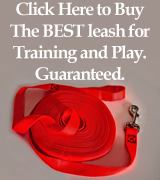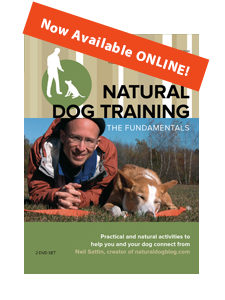In the first part of this natural dog training lesson, we learned how to get your dog into a high state of drive and then, using a small platform to define their space, elicit a "sit" using your dog's natural response to your body language. You are teaching your dog the feeling of "sit" when energized for a purpose: when you're out in the world in "real-life" situations, you want your dog to respond to you ESPECIALLY when they're charged up by whatever's happening in their environment. If you haven't done obedience work with your dog at high energy levels, then your dog will have trouble responding to you when the intensity of the world goes up a few notches. Once you're fluent with part one of the exercise, you'll be ready to move onto part two, which is teaching your dog how to lie down on the box at a high energy level. It's also worth mentioning that all of these exercises can be done with very little (or no) vocal encouragement from you. While I'm going to describe how you might use your voice to your benefit, I suggest that you always start ANY of these exercises by focusing on how your actions and body language influence your dog's behavior. After you've got a feeling yourself for how your dog is responding to your movement and physical cues, then you can add the vocal piece.
Elicit the down response
Once you and your dog get the hang of the first lesson, you will be able to lead your dog up onto the box, and with a simple "whisk away" of your food hand, your dog will sit expectantly. At this point you should have noticed your dog's sensitivity to the edge of the box. If you hadn't been using a box, your dog might have simply followed your whisk-away hand. With your dog on the box, the hesitation created at the edge moves your dog from "hunting-chase" mode into "hunting-wait" mode, and sitting is the natural response. Now you're going to use a combination of your hand position and this "hunting-wait" mode to get your dog into a "Down".
- Push with your dog to get the motor revving. You are engaging your dog's prey instinct to put them into a state of high drive.
- Lead your dog onto the box and into a "sit". Use the techniques you learned in lesson one to get your dog into a sit in a state of drive.
- Feed the position. Give your dog some food to maintain the sit.
- IMPORTANT STEP - Tempt your dog with some food, and do the "whisk away". Only this time, whisk away in a downward direction (i.e. towards the ground in front of your dog). You'll probably need to crouch down in order to do this correctly, so bend those knees! You are using your body position and your dog's "hunting-wait" response to elicit a down.
At this point, one of three things will probably happen. Here's what might happen, and what you should do:
- Your dog lies down immediately. ZING YOUR DOG PRONTO! Then feed the down position. Keep feeding the position until you are ready for your dog to get up. At that point (when you're ready to end the down), give your dog a "Ready...Sparky!" and back away from the box to do some pushing with them (off the box). Repeat the cycle.
- Your dog jumps off the box. You treat this the same way that you did in part one of this exercise. Lead your dog back up onto the box and into a sit. If you can be quick with your food hand (you should be by now!), zing your dog upon getting on the box, whiskaway/zing for the sit, and then try using the whiskaway/zing again (combined with your hand position and direction) to get the dog into a down position. You might need to go through this several times before your dog gets the idea of what they're supposed to do. That's fine. Just be patient, and keep working it.
- Your dog doesn't know quite what to do and looks at you confusedly. If this happens, then you ever-so-subtly can place your left hand (I'm assuming that you're feeding with your right hand) on your dog's back, between the shoulder blades, and apply an ever-so-slight amount of downward pressure to help guide your dog into the down position. When your dog goes down, zing immediately and feed the position. If your dog resists, you can try increasing the pressure a little - but that might make your dog jump off the box (see #2 for how to respond).
To maintain the down (aka what to do if your dog wants to pop right back up again):
If you're dog is really revving, then you might find yourself with a dog who wants to get right back up after lying down. You need to start creating some solidity in the down position. Mainly, you will do this by "feeding the position" - and what is probably happening is that you yourself are getting up and your dog is responding to your body position. So feed your dog's position while you maintain your own crouched position. You want to feed rapidly enough so that there isn't time between zings (i.e. when you're reaching into your food pouch) for your dog to get up. As your dog settles into the position, you can space out your zings. Ever so slowly (and zinging all the while), work to get your body back into an upright position.
Another important component of stabilizing the down is to begin massaging your dog with your left hand as you zing with your right (feeding the position). As your dog relaxes, you can even stop feeding and switch entirely to a relaxing touch to help anchor your dog into position. You'll notice your dog developing a rootedness in the spot the more that they relax.
One last option for you to try, once your dog seems relatively rooted in position, is to tug slowly and steadily on their leash, as if you were trying to pull your dog off the box. Don't pull so hard that you actually pull your dog off! Pull gradually, and notice that your dog resists your effort and "pulls" back, in order to stay on the box (and in the down position). Once your dog resists, relax the tension on the leash and feed the position some more.
You will detect that THIS down is a different kind of down. Your dog will be energized and extremely focused on you. There will be an intensity to the down, but your dog will be quite still - so if you notice things like tail wagging or a concerned facial expression (note ear position especially) - that is a sign that you need to help your dog relax more in this position. While your dog knows how to lie down when energized (that is, after all, why they're doing it right now), you are teaching your dog how to lie down when energized around YOU. Once your dog is reliably lying down, you can add a vocal "Down!" - but make sure you say it just as your dog is lying down. Eventually your dog will learn something like "oh - this word "Down" means that I should feel the way I feel right now, which is to be hitting the dirt in an energized state with a focused direct alertness about me". Something like that.
Once your dog gets the down, you're probably going to spend most of your energy working on down, followed by the "stay". We'll cover the "stay" in Part Three of this series - in the meantime, you can cycle between play training, pushing, getting on the box, sitting on the box, and lying down on the box. Keep things fun for you and your dog by changing things up. If you're walking down the street with your dog and you see an empty bench, use that as an impromptu "box" to transfer some of your work to a more public (and distracting) location. While you're playing fetchtug with your dog, tease your dog with a toy to get them onto the box, and then use the TOY to elicit the down response. You can throw the toy as a release for the down. Whatever you do, just make sure that you're developing a "pop-up free" down, on which we can build as soon as we start talking about "stay". Good luck and, as usual, let me know if you have any questions.





Trackbacks/Pingbacks